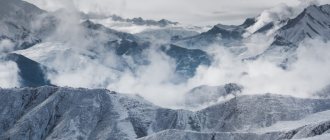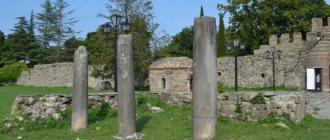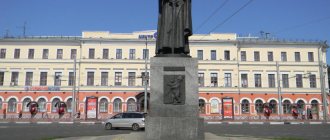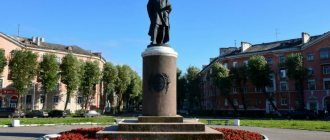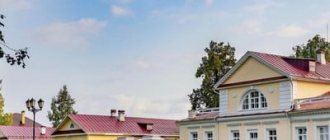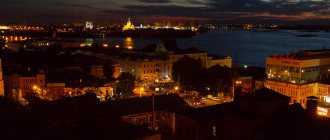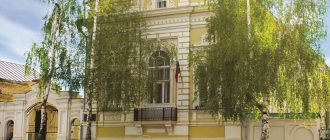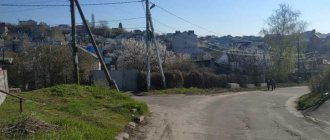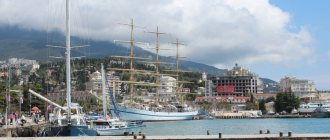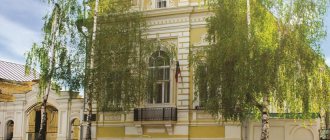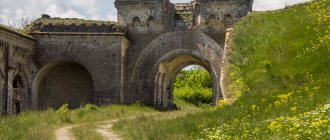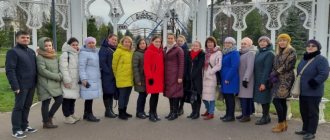Minsk, the capital of Belarus, evokes true delight with its unique sights. It stands on the Svisloch River, first mentioned in the ancient “Tale of Bygone Years” in the 11th century. In his lifetime he has seen a lot: wealth and decline, peace and crushing warriors. Each era, each historical event through which the city passed brought a special feature to its appearance and life. We will consider in detail what a tourist should see in Minsk and where exactly it is worth going to get to know it as closely as possible.
Minsk: TOP-4 must-sees in 1 day
Like any other city, Minsk has objects of its own special pride, which not only give a complete picture of the city, but are also its symbols. And although tourists come here, as a rule, for 2-3 days, you can visit the attractions listed below in just one day.
Trinity Suburb
- Address: Starotroitskaya Square.
Part of the “Old Town”, partially preserved to this day. The first settlements appeared here in the 16th century. The Slavs built wooden huts and practiced rural crafts. Emperor Alexander I gave this area a new start. By his decree, large-scale construction of luxurious estates, parks and squares began here.
It was Alexander who gave the Trinity Suburb its name. Rich landowners bought up lands, and merchants opened shops selling overseas goods on the streets. Life flowed peacefully and measuredly until the 20th century disrupted this peace.
The revolution and World War II caused the loss of many historical buildings. For a long time, the Trinity Suburb lay in ruins. Restoration progressed at a quiet pace and took many years. Modern scientists do not recognize the area as a historical center, since most of the buildings are only copies of ancient buildings.
However, there are several original pieces of 19th-century architecture that you can see on your own or with a guided tour. For example, the premises of the shoe factory of the Jewish manufacturer M. Tsitver and the house where the Belarusian poet Yanka Kupala lived.
Trinity Suburb is an attractive place for walking, reminiscent of a European province. Once here, you can wander through the narrow streets paved with stonework preserved from ancient times. Admire the cute colorful houses covered with ivy, look into a cozy coffee shop, an antique shop, a second-hand bookstore and just enjoy the beauty of this green island.
Park Museum of Interactive History “Sula”
- Address: Minsk region, Sula village, 14.
The country's first museum of interactive history was located on the banks of the Sula River, after which it was named. Its main asset is the residence of Stefan Batory, the king of the Polish-Lithuanian Commonwealth, restored from ruins. This building is made of cut brown stone, rebuilt according to surviving documents from the 16th century. In addition to the royal palace, wooden Slavic buildings were rebuilt here, demonstrating the life and way of life of the peasants.
The museum is located in a picturesque place: the banks of the river are covered with greenery, and hundred-year-old trees grow next to the buildings. In addition, there is a stable on the territory where thoroughbred horses are bred.
The excursion includes an introductory story about the history of Sula, a visit to the estate complex, as well as an art event dedicated to the formation of Belarus. A special animated program called “Journey to the Past” is held for schoolchildren. Within its framework, a skit is played out during which a “resident” of the ancient city, dressed in a national costume, tells the children the history of his homeland.
National Art Museum
- Address: Lenin street, 20.
The National Art Museum opened in 1939. His extensive collection is housed in a magnificent stone building in the classicist style. It is easily recognizable by the antique columns and sculptures placed in niches on both sides of the main entrance and on the roof.
The art galleries are divided into several thematic rooms dedicated to individual artists, subjects, ancient history of different countries and mythology. Each room is decorated in an individual style, reflecting the character of the works and creating the appropriate atmosphere. Here you can see paintings by great Russian painters known throughout the world. Among them are Ivan Aivazovsky, Ilya Repin, Eduard Khrutsky and Isaac Levitan.
The collection of this cultural landmark of Minsk contains more than 27 thousand valuable exhibits, which makes it the largest art center in all of Belarus.
Bolshoi Opera and Ballet Theater
- Address: Place de Paris Commune, 1.
The only Bolshoi Theater in the country is located in a pompous building designed by the outstanding Belarusian architect Joseph Langbard. The inspired artist put all his soul and talent into the project and created a true masterpiece of architecture.
The snow-white building in the post-constructivist style is distinguished by its non-standard shape and exquisite decorations in the form of bronze statues of ancient Greek gods, patrons of art. The theater of unearthly beauty is located in a place corresponding to its appearance - on the spacious square of the Paris Commune. Directly in front of the building, jets of a large fountain rise into the air, turning into a decorative pond.
The theater was badly damaged during the Great Patriotic War. The very first bombing caused significant injuries to him, and the fascist invaders plundered the remaining interiors and set up a stable yard in the premises. The bitter time did not affect the modern form of theater. After restoration it began to look like new. In 2009, the facade sculptures were updated.
Today the theater's repertoire includes more than 80 opera and ballet productions. Among them there are classical and modern works that can impress both children and adults. The cultural program includes not only performances, but also a tour during which visitors will be told the history of the establishment.
Reviews from tourists
- Svetlana
The climate and well-groomed environment of the Belarusian capital, friendly people, beautiful colorful houses and modern sculptures leave an indelible impression on the tourist’s soul. It's nice to see forested areas right in the middle of the city and use the Minsk metro, the fare of which is only 0.55 BYN.
- Lyudmila
I saw Minsk in the evening for the first time and was shocked by the wide sparkling avenues and buildings with beautiful lighting. The people are calm, friendly, welcoming and almost no one speaks Belarusian.
- Cheelena
I liked the silence, tranquility and safety in the city, cleanliness and good roads.
Hotels in the capital are a bit expensive, but it is quite possible to find decent private accommodation for a reasonable price. You can rent a car and drive around the country. Fortunately, Minsk is located very well, almost in the very center of the republic. Before traveling to Minsk, the most difficult question will be where to go, especially if time is limited. om bus. In 2 days, get to know the historical part of the city in detail and visit the theater. You will be able to see a lot in 3 days if you first plan your route on a map of Minsk and correctly calculate your strength.
The main museums of the Belarusian capital
In Minsk there are museums for every taste: historical, everyday, miniature and completely original, which you will not find in any other city.
National Historical Museum of the Republic of Belarus
- Address: st. Karl Marx, 12.
The History Museum was founded more than a hundred years ago in a building that once belonged to the Assembly of the Nobility. The collection was constantly supplemented with new relics: regalia confiscated by the Bolsheviks from former princes and nobles, military, archaeological artifacts and objects of folk art.
All these exhibits were lost in the 1940s. The museum employees, saving their own lives, did not have time to evacuate the museum’s valuables, which were either destroyed or taken to Germany. To date, the walls of the attraction have been filled with updated compositions, numbering over 40 thousand storage units. There are several permanent exhibitions here:
- The exhibition “Ancient Belarus” is dedicated to the history of the country, from the Neolithic to the 19th century. It tells about how the Belarusian land was settled, how the first tribal unions and villages arose, as well as about the era of the Grand Duchy of Lithuania, the Polish-Lithuanian Commonwealth and the Russian Empire.
- “Belarus XVI-XVIII centuries. in portraits." Portraits of the rulers of the Grand Duchy of Lithuania and the Polish-Lithuanian Commonwealth are presented here, as well as samples of weapons, dishes and jewelry found during archaeological excavations.
- "Belarus: revival of spirituality." The section talks about the formation of religious life in Belarus, the formation of moral values and the evolution of religious rituals.
- “Museum Treasury” is the most significant exhibition showing ancient objects that have no price. Among them are jewelry belonging to rulers, golden cups, ancient weapons and musical instruments, costumes, handwritten books and even a treasure of Roman denarii.
In addition, the museum hosts creative competitions and general educational events, which are useful to take your child to.
State Museum of Folk Architecture and Life
- Address: Shchomyslitsky village council, agricultural town of Ozertso.
The open-air museum was founded in December 1976. Its territory is conditionally divided into three historical and ethnographic regions:
- Central Belarus,
- Dnieper region,
- Poozerye.
The architectural design of each region corresponds to the buildings characteristic of it in the 19th-20th centuries. Currently, the museum houses more than twenty monuments to wooden Belarusian architecture. Among them there are places of worship (churches, chapels), outbuildings (barns, stables), work premises (blacksmiths, mills), schools and residential buildings.
The interiors have a traditional design. The decorations consist of household utensils, which the inhabitants of such settlements could not do without. The final touch to the atmosphere of the museum is made by green fences, gardens and wells. All this is organized so that the tourist can vividly imagine the life of his ancestors.
Museum of miniatures "Country Mini"
- Address: ave. Independence, 25.
“Mini Country” is the only museum of miniatures not only in Minsk, but throughout Belarus. It was opened on the initiative of Evgeniy Danilik in December 2016. The young museum developed quickly and soon became very popular. Its exhibition consists of miniatures of 22 Belarusian landmarks.
Here you can see tiny castles, monuments and tourist areas of the Republic. Each object is recreated down to the smallest detail, down to the street lamps and carvings on the window casings. In the future, it is planned to increase the number of exhibits to 70 units, which will allow you to visit everything in one place.
Boulder Museum
- Address: Uruchye microdistrict.
We are talking about the park museum, created in 1985 by academician-enthusiast Gavrila Goretsky. The institution is a display of the map of the country through huge stones and living trees. The map is presented on a scale: 1 m wide = 2 km, and 1 m high = 100 m. The borders of the Belarusian state are marked by low, evenly trimmed bushes.
Areas are marked by blue spruce trees, rocky paths represent rivers, and small fountains represent lakes. Large boulders scattered across the map are cities and mountains. It is worth noting that the stones marking this or that area were actually brought from there.
The most significant exhibits of the museum are the “Cross of Stefan Batory” (there is a legend that the king dined at its foot), the “Grandfather” boulder - a stone with a carved image of a face taken from the site of a pagan sanctuary, and an ancient millstone in which grain was ground. Since the late 1980s. The Boulder Museum is considered a natural monument of republican significance.
Trinity Suburb
There is an ancient district in Minsk. There are houses in pastel colors and tiled roofs. The suburb is located on the banks of the Svisloch. In the 12th century there were wooden buildings here and it was the main place of trade in the city. During its existence, the area was severely damaged. At the beginning of the 19th century there was a fire here, in the middle of the 20th century the building was destroyed again. Already in the 80s, the suburb was reconstructed.
Today the area resembles an ancient city. There are antique shops and coffee shops here. If you want to take a break from the hustle and bustle, then Trinity Suburb is exactly what you need.
Pearls of architecture in Minsk
Despite the antiquity of the city, its buildings mainly consist of stylish, modern buildings that surprise with their extraordinary architecture.
National Library of Belarus
- Address: Independence Avenue, 116.
The library building is one of the most recognizable and memorable in Minsk. It is made in the shape of a rhombicuboctahedron - a polyhedron consisting of cubes and triangles. The total number of faces in it reaches 26.
A glass building is associated with crystal. This definition is especially suitable for the library at night, when the façade is illuminated with a ghostly blue light. It was not without reason that the author of the project chose the shape of a crystal for the library building. So he wanted to display the preciousness and strength of knowledge.
The library has 23 floors, on which there are reading rooms, recreation areas, lecture halls, art galleries, a library museum, and a fitness center with a sauna. On the upper floors there are observation platforms available to visitors.
Republican Palace of Culture of Trade Unions
- Address: Independence Avenue, 25.
The Palace of Culture opened its doors in the late 1950s and since then has played an invaluable role in the cultural life of the city. It is located in a building that resembles a Greek temple rather than a municipal office.
The luxurious architecture impresses with rows of tall columns, molded capitals, figured cornices and lancet windows. The triangular portico with a niche is decorated with marble sculptures of the mythical gods of Olympus. The building is designed in light colors, which gives it a heavenly airiness.
The interior of the palace serves as a venue for pop concerts, theatrical performances and scientific lectures. There are photography and painting studios and creative clubs for children and adults. The number of students exceeds 1500.
Minsk City Hall
- Address: Freedom Square, 2a.
City Hall is a symbol of freedom. It was built in the 17th century, when the ruler of the Grand Duchy of Lithuania, Alexander, gave the townspeople Magdeburg Law, which allowed Minsk residents to establish a magistrate (self-government body) and place it in the town hall.
The newly erected building was a white stone building in a pseudo-Gothic style. It was decorated with massive columns, verandas with balusters and a tower setting under the spire, in the center of which was a clock.
When Belarus joined Russia, Magdeburg Law was abolished, and the town hall was used at various times as a court, theater, music school and archive. In the 1850s, by decree of Nicholas I, the building was demolished due to dilapidation. However, other sources claim that the emperor did not want anything to remind the Minsk residents of their former freedom.
The restoration of the town hall took place in 2003. The new building completely replicates the appearance of its ancient predecessor. It now hosts exhibitions on the history of Magdeburg Law, and also hosts meetings and official receptions.
Gate of Minsk
- Address: Kirova street, 1.
The gates of Minsk greet visitors to the city when leaving the Railway Station - this is a pair of 11-story towers in the Stalinist Empire style.
On top of one of them there is a German clock with chimes, taken from Germany in 1945 as a trophy. The clock is truly huge: its diameter is 3.5 m, and the length of the minute hand reaches 1 m 69 cm. On the other tower is the coat of arms of the Belarusian Soviet Socialist Republic, left over from old times.
The towers were built in 1953. In the adjacent five-story buildings there are apartments where station and railway employees live.
Yanka Kupala Park
On the territory of the park there are:
- Yanka Kupala Literary Museum;
- monument to a classic of Belarusian literature;
- fountain "Wreath".
The fountain is dedicated to the folk holiday of Ivan Kupala, when at night girls told fortunes about their betrothed. This moment was captured by the author of the project. Two bronze figures of girls perch on the edge of a round pool and lower wreaths into the water.
In addition, the park has several stone sculptures based on the works of Kupala.
We leave the park onto Independence Avenue, cross to the other side and in front of us is the interesting building of the Belarusian State Circus.
Beautiful Minsk temples and churches
The churches of Minsk were built in different years, in different styles and for parishioners of different faiths, but they serve a single goal - the spiritual enlightenment of the people.
Church of St. Simeon and St. Helena
- Address: Sovetskaya, 15.
The Catholic church was built at the beginning of the 20th century. This red brick building with high towers and stained glass windows was popularly nicknamed the “Red Church”. A huge contribution to the construction of the Catholic landmark was made by the Minsk nobleman and politician Edward Voinilovich, who donated a large sum for the construction.
The only favor the benefactor asked for was to name the future temple in honor of his deceased children. Edward had two of them: his son Semyon, who died of scarlet fever at the age of 13, and his 19-year-old daughter Elena, who was killed by pneumonia. The request of the grieving father was fulfilled - the church was consecrated in honor of St. Simeon and St. Elena.
The temple did not receive parishioners for long. The revolution and subsequent persecution for faith led to the closure of more religious institutions. During the USSR, theaters, museums, and cinemas were located in the premises of the church. The building was returned to Catholics in the 1990s, and after renovations it resumed liturgical activities. Since 2022, the park next to the church has been named after Edward Voinilovich.
Cathedral of the Descent of the Holy Spirit
- Address: st. Cyril and Methodius, 3.
In the first half of the 17th century, a Catholic convent stood on the site of the modern cathedral. The monastery consisted of wooden buildings, which by the 18th century were completely destroyed by termites and fires.
The monastery was moved to Nesvizh, and the land was given to an Orthodox church. In place of the wooden churches, a white-stone cathedral with two multi-tiered bell towers and covered galleries grew up. The temple was closed in 1922, but during the war years it was restored and never ceased its activities.
Currently, regular services are held in the cathedral. Valuable relics are kept within its walls, including the ancient Miraculous Icon of the Mother of God, which was first brought to Minsk more than 500 years ago.
All Saints Church
- Address: Kalinovsky, 121.
The young temple was founded in 2008 and consecrated in the name of All Saints and in memory of the war heroes who gave their lives for the defense of the Motherland. The stone church is striking due to its abundant decorations.
Gilded elements stand out on the white walls: decorative barrels, domes, arrows and triangular visors. The high hipped roof is crowned with a golden dome. In the niches above the main entrance there are mosaic images of Saints. In addition to the main temple, the complex includes chapels, refectories, fonts and an Orthodox gymnasium building.
In the summer of 2010, a ceremonial burial of the remains of three unknown soldiers who died in the battles of three great wars: the Patriotic War of 1812, the First World War and the Great Patriotic War took place in the church crypt.
Alexander Nevsky Church
- Address: Kozlova, 11.
The church is located on a military cemetery, which is no coincidence, because it was built in honor of the Belarusian soldiers who died in the battles of the Russian-Japanese War. On its territory there are many monuments and burials, including mass graves.
The church was built in 1898 in the classical Byzantine style. The main building and the adjacent hipped bell tower are made of red brick and decorated with whitewashed decorative elements. The peculiarity of the building is that it was preserved in perfect condition, although it lived for more than a century and saw a lot of war. Once, during a bombing, a shell fell on the temple, but the explosive device did not go off, and the building miraculously survived.
This temple contains several significant artifacts: a wooden chapel left over from the times of the Russian-Turkish War, and an ancient icon - the original work of the artist Nikolai Nikolaevich Ge.
National Library
It is difficult to imagine a tourist who has been to Minsk and not visited the National Library. The building is presented in the form of a rhombicuboctahedron and was built in 2006. At the entrance to the library, tourists are greeted by Francis Skorina; inside there are more than 10 million copies of books and newspapers.
Note!
Tourists can not only visit the library, but also go up to the observation deck. It is located at an altitude of 73 meters, from here the entire city is visible at a glance.
War memorials and monuments of Minsk
The Great Patriotic War was a dark streak in the life of Minsk, which began suddenly and seemed never to end. In June 1941, the first bombing hit the city, and soon it was occupied by the German invaders. During the Second World War, three Jewish ghettos were formed on the territory of the Belarusian capital, and bloody battles took place in the vicinity of the city. The war claimed the lives of 70,000 Minsk residents. In memory of the shattered destinies and chilling events, countless memorial plaques have been installed in the city squares.
Square of victory
- Address: Victory Square.
The oval-shaped square was laid out in 1945. At the same time, a 38-meter stone stele with the Order of May 9th on top was installed in its center. At its foot the Eternal Flame burns, and under its base there are capsules filled with the soil of the hero cities:
- Moscow,
- Kyiv,
- St. Petersburg, etc.
On the roofs of the houses surrounding the square, the inscription “The feat of the people is immortal” stands out in bright red.
The memorial complex is not limited to the square, but goes deep underground. In the passage of the Victory Square metro station there are memorial plaques with the names of 566 hero soldiers who died during the liberation of Minsk carved out.
Belarusian State Museum of the History of the Great Patriotic War
- Address: ave. Winners, 8.
The Museum of the History of the Great Patriotic War is the only museum that was opened during the difficult years of war. The collection of materials, documents and relics began in June 1942. All of them were devoted to two topics:
- “The treacherous invasion of German fascism in the USSR”;
- "The heroic struggle against the fascist occupiers."
By the end of the war, the museum's collection included thousands of exhibits, including official and personal documents, photographs, newsreels, memoirs, art books, newspaper clippings and letters. Gradually, the archives were replenished with samples of bladed weapons and firearms, as well as personal belongings donated by veterans.
Today the museum is located in a modern building built in an arched shape. You can notice it from afar thanks to the glass dome with the flag. The large space allowed the institution’s staff to create landscape models illustrating military operations, and to include in the exhibition authentic military equipment, train carriages and reconstructed dugouts of underground resistance organizations.
At the entrance to the museum there is a multi-meter memorial stele, and next to it there is a sculpture of a woman symbolizing Victory.
Memorial "Pit"
- Address: Zaslavskaya street.
The Holocaust Memorial was erected on the site where 5,000 Jews, including small children, were shot on March 2, 1942.
The first monument appeared here in 1947. Stonecutter Mordukh Sprishen made the monument, and the poet Chaim Maltinsky prepared a memorial text in two languages - Russian and Yiddish. Two years later, both men were arrested and sent to Gulag camps because the inscription referred to the victims as “Jews” rather than “peaceful Soviet citizens.” This formulation was perceived as a manifestation of “Jewish bourgeois nationalism.”
The monument, however, was preserved. In 2000, a sculptural composition by Alexander of Finland appeared along the steps leading to it. It is called “The Last Journey” and depicts the martyrs of the Jewish ghetto, doomed to execution. They seem to be descending into a dark pit of nothingness.
All elements of the composition, from the figures themselves to the pedestals, were sculpted by hand, without the use of any technical devices.
Island of Courage and Sorrow
- Coordinates on the map: 53.909699, 27.554510.
Located on the Svisloch River, the memorial complex is dedicated to the heroes of the Afghan War. It is a round island, to which a curved bridge leads. On a small plot of land there is a chapel, on the walls of which 700 names of Belarusians killed in Afghanistan are engraved. Next to her, a bronze sculpture of the Weeping Angel darkens. Transparent drops - tears - ooze from the Guardian's eyes.
Independence Square
One of the largest areas in Europe, occupies approximately 7 hectares. But once in the center, tourists do not have the feeling that there is a huge space here. There is an architectural ensemble around, the Red Church.
The square was founded in 1934. From here begins Independence Avenue, which is 15 km long. This is one of the longest highways in Europe.
During its existence, the square was modified many times. Today it is a wonderful place for walking and relaxing. There is a shopping center nearby where you can not only shop, but also have a snack in a cafe.
Nature of the city of Minsk and its surroundings
Minsk, although it is the capital and largest city of Belarus, has not turned into a concrete jungle, but remains “green,” which makes both local residents and tourists very happy.
Botanical Garden
- GPS coordinates: 53.914314, 27.613071.
The most extensive natural area of the city. It was created by members of the Belarusian Academy of Sciences and is under its patronage. The garden can only be visited as part of a tour, because it is not a walking park, but a real open-air museum. There is an extensive collection of ornamental, exotic and household plants.
The total number of species reaches 15 thousand. The garden is divided into various climatic zones - from the Siberian taiga to the tropics. All trees and bushes are neatly trimmed, lawns are well-groomed. Along the alleys there are paved paths, and in the shade of the treetops you can see cozy benches where you can relax and enjoy the beauty of the landscape.
Zaslavskoye Reservoir
- Coordinates: 53.980198, 27.387145.
A large artificial reservoir is located outside the city of Minsk, in picturesque surroundings. Its area is 31 km2, and its depth reaches 8 m. Initially, the reservoir was created to regulate river flows, but later Minsk residents adapted it for their needs and entertainment.
In several places along the water, marinas have been built, beaches are equipped in places suitable for swimming, and in the quiet backwaters there are ruffs, pikes, perches and bleaks, which attracts fishermen. Also on the shore there are sanatoriums and health centers.
Take a photo at the tower crane graveyard
Few people can boast of taking a selfie from the cemetery of tower cranes. That is why this rare place, even for large cities, cannot be missed in Minsk. The urban landscape with the atmosphere of a post-industrial apocalypse attracts stalkers of all ages. There is no point in sneaking into an area surrounded by a fence with barbed wire and studded with cameras. You can take some cool photos from the outside as the tower cranes look best from a distance. And the exhibition is constantly updated!
The most unusual cemeteries in the world
Find the cheapest tickets to Minsk
Rent a car in Minsk
Minsk for children: where to go, entertainment
Married couples traveling with children will be pleased to know that in Minsk there are many places that will provide their child with an exciting time.
Separate article: What to see in Minsk with a child
Minsk Zoo
- Address: Tashkent street, 40, Chizhovka.
Minsk Zoo is called a museum of living nature. It was founded in 1984 and is home to more than 400 species of exotic animals. A wide variety of fauna live in spacious enclosures:
- pumas and peacocks,
- parrots and crocodiles,
- snow leopards and monkeys,
- mountain goats,
- fur seals, etc.
Each animal has a name and its own unique story, which can be read on a stand near the enclosure. The zoo often hosts entertainment and charity events, and there are children's clubs where children get to know animals and learn how to care for them.
Dinopark
- Address: Tashkent st., 40.
After showing your child the modern inhabitants of our planet, you can go to the Dinopark and tell about the ancient lizards that lived millions of years before us. The park features meter-long figures of dinosaurs that look as realistic as possible, and the motor and sound equipment makes them even more impressive.
Pishchalovsky Castle
Address
: st. Volodarsky 2.
The castle was founded in 1825 and is one of the oldest surviving buildings. Refers to neoclassicism. From the very beginning it was intended to hold political prisoners: thick stone walls are surrounded by an equally powerful fence. Famous poets, revolutionaries, writers and artists served their sentences here. During the Soviet era, executions took place. Nowadays, there is a pre-trial detention center here, so inspection is only accessible from the outside.
City Hall. Photo: Allerdings69
